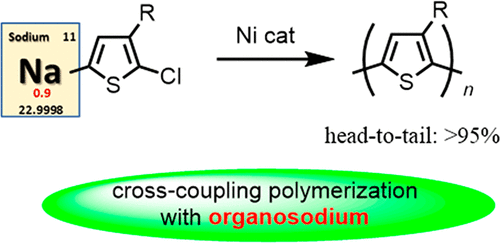当前位置:
X-MOL 学术
›
Organometallics
›
论文详情
Our official English website, www.x-mol.net, welcomes your
feedback! (Note: you will need to create a separate account there.)
Cross-Coupling Polymerization of Organosodium for Polythiophene Synthesis
Organometallics ( IF 2.5 ) Pub Date : 2021-10-19 , DOI: 10.1021/acs.organomet.1c00508 Tomoki Inoue, Sonoka Yamamoto, Yuma Sakagami, Masaki Horie, Kentaro Okano, Atsunori Mori
Organometallics ( IF 2.5 ) Pub Date : 2021-10-19 , DOI: 10.1021/acs.organomet.1c00508 Tomoki Inoue, Sonoka Yamamoto, Yuma Sakagami, Masaki Horie, Kentaro Okano, Atsunori Mori

|
Treatment of 2-chloro-3-hexylthiophene with sodium 2,2,6,6-tetramethylpiperidin-1-yl (TMPNa) in hexane resulted in deprotonation at the 5-position to afford the thiophene–sodium species, whose formation was confirmed by quenching with iodine, leading to 2-chloro-3-hexyl-5-iodothiophene in 85% yield. Addition of a nickel catalyst bearing an N-heterocyclic carbene (NHC) to the thus-formed thiophene–sodium species in cyclopentyl methyl ether induced a cross-coupling polymerization at −20 °C. After the reaction mixture was stirred for 24 h, poly(3-hexylthiophen-2,5-diyl) was obtained in 56% yield. The average molecular weight Mn was revealed to be 9700, which was close to the theoretical molecular weight (M = 8500) on the basis of the monomer feed/catalyst loading ratio (2.0 mol %), and the molecular weight distribution was found to be 2.1.
中文翻译:

有机钠交叉偶联聚合合成聚噻吩
在己烷中用 2,2,6,6-四甲基哌啶-1-基钠 (TMPNa) 处理 2-氯-3-己基噻吩导致 5-位去质子化,得到噻吩-钠物质,其形成由用碘淬灭,产生 2-chloro-3-hexyl-5-iodothiophene,产率为 85%。将带有 N-杂环卡宾 (NHC) 的镍催化剂添加到环戊基甲基醚中由此形成的噻吩-钠物质中,在 -20°C 下引发了交叉偶联聚合。将反应混合物搅拌24小时后,以56%的产率获得聚(3-己基噻吩-2,5-二基)。平均分子量M n为 9700,接近理论分子量(M = 8500) 基于单体进料/催化剂负载比 (2.0 mol %),发现分子量分布为 2.1。
更新日期:2021-11-08
中文翻译:

有机钠交叉偶联聚合合成聚噻吩
在己烷中用 2,2,6,6-四甲基哌啶-1-基钠 (TMPNa) 处理 2-氯-3-己基噻吩导致 5-位去质子化,得到噻吩-钠物质,其形成由用碘淬灭,产生 2-chloro-3-hexyl-5-iodothiophene,产率为 85%。将带有 N-杂环卡宾 (NHC) 的镍催化剂添加到环戊基甲基醚中由此形成的噻吩-钠物质中,在 -20°C 下引发了交叉偶联聚合。将反应混合物搅拌24小时后,以56%的产率获得聚(3-己基噻吩-2,5-二基)。平均分子量M n为 9700,接近理论分子量(M = 8500) 基于单体进料/催化剂负载比 (2.0 mol %),发现分子量分布为 2.1。


















































 京公网安备 11010802027423号
京公网安备 11010802027423号